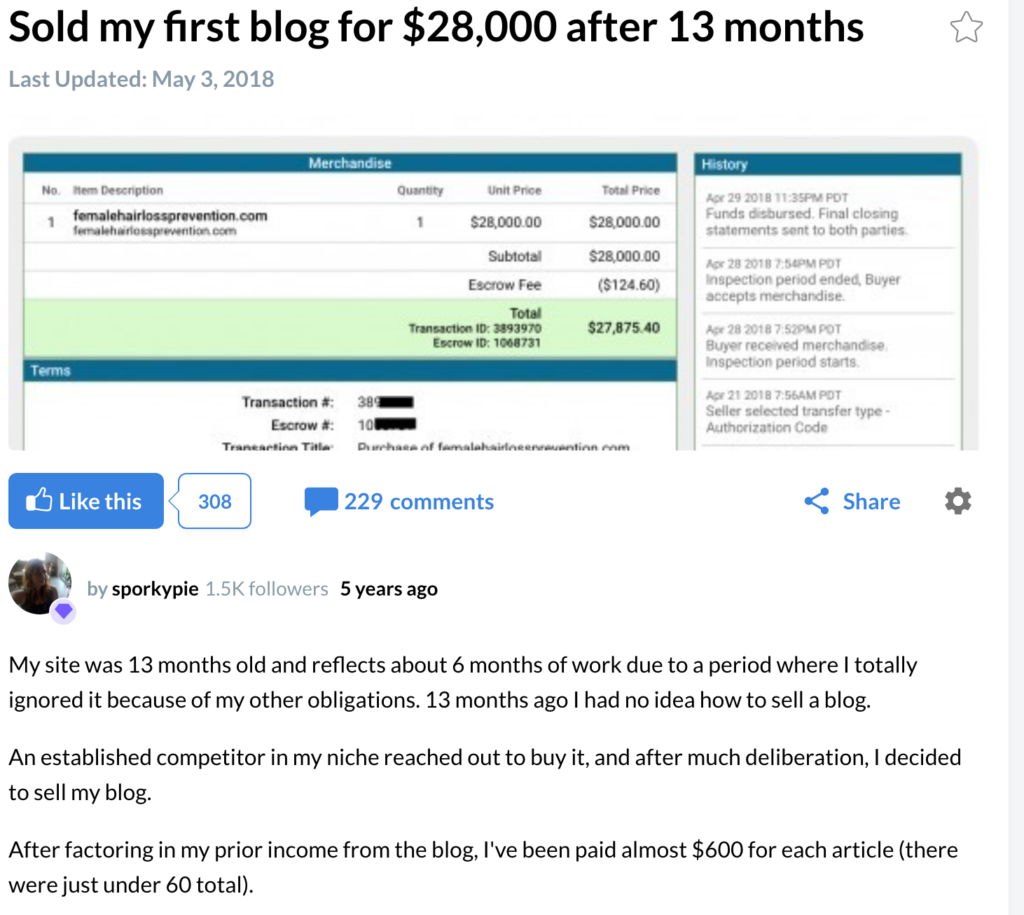Hey there, fellow aspiring bloggers and digital entrepreneurs!
If you’ve ever dreamt of turning your passion for blogging into a rewarding income stream, you’re in the right place.
We’re about to embark on a journey that could take you from being a blogging novice to a monetization maestro.
Imagine this: You, sitting by the beach, sipping a refreshing beverage, all while your blog is quietly making money in the background.
Sounds enticing, right?
Well, that’s precisely what we’re here to explore—how to transform your blog into a thriving affiliate marketing powerhouse.
It’s not just about scribbling words on the internet; it’s about crafting a strategy that turns those words into dollars.
And guess what?
You don’t need to be a tech genius or a marketing guru to make it happen.
Affiliate marketing is like the secret sauce of the blogging world.
It’s the art of partnering with brands and businesses to promote their products or services on your blog.
When your readers click on those carefully placed affiliate links and make a purchase, you earn a commission.
It’s a win-win-win scenario: Your readers find valuable products, the businesses make sales, and you earn a slice of the pie.
But here’s the kicker—this path to profitability isn’t just a matter of luck.
It’s a well-trodden road with signposts and strategies that can lead you to success.
And today, I’m handing you the roadmap.
In this step-by-step guide, we’re going to break down the process of monetizing your blog through affiliate marketing into bite-sized, actionable chunks.
Whether you’re a newbie taking your first steps into the blogosphere or an experienced blogger looking to boost your earnings, there’s something here for everyone.
We’ll cover everything from choosing the right niche to crafting compelling content, driving traffic to your blog, selecting the best affiliate products, and optimizing your strategy for maximum returns.
It’s going to be an exciting ride, filled with insights, tips, and success stories from bloggers who’ve already cracked the code.
So, let’s roll up our sleeves, fire up those laptops, and get ready to turn your blog into a money-making machine.
By the time we’re done, you’ll have the tools, knowledge, and confidence to take your blogging journey to the next level.
Let’s make that dream of earning income from your blog a reality.
Ready? Let’s dive in!
RECOMMENDED: Best Online Business (Free Guide)
Chapter 1: Setting the Foundation
Welcome to the first chapter of your journey to monetize your blog through affiliate marketing!
Just like building a sturdy house requires a solid foundation, creating a profitable blog starts with setting the right groundwork.
In this chapter, we’ll focus on two crucial aspects: Choosing a Blog Niche and Starting Your Blog.
Choosing a Blog Niche
Think of your blog niche as the compass that guides your blogging journey.
It’s the subject or topic you’re passionate about and knowledgeable in.
Your niche should align with your interests, expertise, and the interests of your target audience.
Here are some tips to help you select the perfect niche:
1. Passion and Knowledge
– Blogging becomes more enjoyable when you’re passionate about your niche.
– Your expertise in the niche will shine through in your content.
2. Audience Demand
– Research your niche to ensure there’s an audience interested in the topic.
– Explore forums, social media, and keyword research tools to gauge demand.
3. Competition Analysis
– Assess the competition in your chosen niche.
– Competition can be a good sign, but also consider if you can bring a unique angle or perspective.
4. Monetization Potential
– Investigate whether there are affiliate programs and products related to your niche.
– Some niches may be more profitable than others.
5. Long-Term Viability
– Choose a niche that you can see yourself blogging about for the long haul.
– Trends come and go, but timeless topics have lasting earning potential.
Once you’ve narrowed down your niche, it’s time to take the next step.
Starting Your Blog
Starting a blog may sound like a daunting task, but fear not—it’s more accessible than ever.
Follow these steps to launch your blog:
1. Domain and Hosting
– Choose a domain name that reflects your niche and is easy to remember.
– Select a reliable hosting provider to host your blog. Options like Bluehost, SiteGround, and HostGator are popular among bloggers.
2. Blogging Platform
– Opt for a user-friendly blogging platform like WordPress (my preferred choice)
– Many hosting providers offer one-click WordPress installations.
3. Design Your Blog
– Select a clean and responsive blog theme like GeneratePress.
– Customize your blog’s appearance to match your brand.
4. Essential Plugins
– Install essential plugins like The SEO Framework (for SEO optimization) and Akismet (to combat spam comments).
– Plugins enhance your blog’s functionality.
5. Publish Your First Post
– Write an engaging introduction post to welcome your audience.
– Share your blog’s mission and what readers can expect.
6. Legal and Disclosure
– Create a privacy policy and terms of service pages.
– Disclose your affiliate relationships to maintain transparency with your audience.
7. Promotion
– Share your blog on social media and with friends and family.
– Start building your email list from day one with tools like Aweber.
With your blog set up and ready to roll, you’ve officially taken the first steps toward monetizing it through affiliate marketing.
In the next chapters, we’ll delve deeper into creating quality content, building a targeted audience, and mastering the art of affiliate marketing.
Stay tuned for more valuable insights and actionable tips!
Chapter 2: Creating High-Quality Content

Welcome to Chapter 2, where we dive into the core of your blog’s success: creating high-quality content.
Quality content is the heart and soul of any successful blog, and it’s the cornerstone of your affiliate marketing strategy.
In this chapter, we’ll explore Content Creation Strategies and Keyword Research for SEO to help you craft compelling, search engine-friendly content that attracts readers and drives affiliate sales.
Content Creation Strategies
Creating engaging and valuable content is essential for building a loyal readership and earning trust from your audience.
Here are some strategies to help you create content that stands out:
1. Understand Your Audience
– Before you start writing, get to know your target audience’s preferences, pain points, and interests.
– Tailor your content to address their needs and provide solutions.
2. Plan Your Content
– Create an editorial calendar to organize your blog posts.
– Plan a mix of content types, such as how-to guides, product reviews, listicles, and personal stories.
3. Focus on Quality, Not Quantity
– It’s better to have a few high-quality, in-depth articles than numerous shallow ones.
– Take the time to research, write, and edit your posts thoroughly.
4. Storytelling
– Weave stories into your content to make it relatable and engaging.
– Share personal anecdotes or case studies when relevant.
5. Use Visuals
– Incorporate images, infographics, and videos to enhance your content.
– Visuals break up text and make your content more appealing.
6. Consistency
– Stick to a regular posting schedule to keep your audience engaged.
– Consistency helps build trust and keeps readers coming back for more.
Keyword Research for SEO
To ensure your content reaches a wider audience and ranks well on search engines, mastering keyword research is crucial:
1. Keyword Tools
– Utilize keyword research tools like Google Keyword Planner, SEMrush, or Ahrefs.
– Identify keywords related to your niche and content topics.
2. Long-Tail Keywords
– Target long-tail keywords (phrases with 3 or more words) to capture specific search intent.
– Long-tail keywords often have lower competition.
3. Competitor Analysis
– Analyze your competitors’ content and keywords.
– Identify gaps in their content that you can fill with your own unique perspective.
4. Keyword Placement
– Integrate your target keywords naturally within your content.
– Include them in the title, headers, and throughout the body of your article.
5. Write for Humans, Optimize for Search Engines
– While keywords are essential, prioritize writing for your audience.
– Engaging, informative content tends to perform better on search engines.
6. Monitor and Update
– Regularly review your content’s performance using the Google Analytics tool.
– Update older posts to keep them relevant and improve SEO.
By mastering content creation and keyword research, you’ll be well on your way to crafting blog posts that not only resonate with your readers but also attract organic traffic from search engines.
In the next chapter, we’ll delve into audience-building strategies to ensure your content reaches the right eye.
So, stay tuned and keep those creative juices flowing!
RECOMMENDED: Best Online Business To Start Today!
Chapter 3: Building a Targeted Audience
In Chapter 3, we’ll focus on the essential task of building a targeted audience for your blog.
After all, what good is high-quality content if no one’s around to read it?
We’ll explore strategies for Growing Blog Traffic and Engaging with Your Audience to help you foster a loyal and engaged readership.
Growing Blog Traffic
1. Search Engine Optimization (SEO)
– Optimize your content for search engines by using relevant keywords, meta tags, and high-quality backlinks.
– Regularly update and refresh your older blog posts to improve their SEO ranking.
2. Content Promotion
– Share your blog posts on social media platforms to reach a wider audience.
– Consider guest posting on other relevant blogs to expand your reach and build backlinks.
3. Email Marketing
– Build an email list from the beginning by offering valuable incentives such as eBooks, courses, or exclusive content.
– Use email marketing campaigns to keep your subscribers informed about new blog posts and affiliate promotions.
4. Social Media Engagement
– Be active on social media platforms that resonate with your audience.
– Engage with your followers, respond to comments, and foster a sense of community.
5. Collaborations and Partnerships
– Collaborate with influencers or other bloggers in your niche.
– Partnerships can help you tap into their audience and increase your blog’s visibility.
6. Paid Advertising
– Consider using paid advertising methods like Google Ads or Facebook Ads to drive targeted traffic to your blog.
– Set a budget and target specific demographics to maximize your ROI.
Engaging with Your Audience
1. Respond to Comments
– Encourage reader engagement by responding to comments on your blog.
– Address questions, acknowledge feedback, and create a sense of community.
2. Social Media Interaction
– Engage with your audience on social media by asking questions, conducting polls, and sharing behind-the-scenes content.
– Show your personality and authenticity to connect on a deeper level.
3. Email Communication
– Send personalized emails to your subscribers.
– Share exclusive content, promotions, and valuable tips that cater to their interests.
4. Live Events and Webinars
– Host live events, webinars, or Q&A sessions to interact with your audience in real time.
– These sessions can strengthen your relationship with your readers.
5. Surveys and Feedback
– Use surveys to gather feedback from your audience.
– Adjust your content and strategies based on their preferences and needs.
6. Consistency and Reliability
– Maintain a consistent posting schedule and deliver content as promised.
– Reliability builds trust, and trust leads to reader loyalty.
Building a targeted audience takes time and effort, but it’s a vital step on your path to monetizing your blog through affiliate marketing.
By implementing these strategies and genuinely connecting with your readers, you’ll create a dedicated community eager to engage with your content and recommendations.
In the next chapter, we’ll dive deeper into the world of affiliate marketing, discussing how to choose the right affiliate products and create compelling affiliate content.
So, stay tuned and keep building those connections!
Chapter 4: Affiliate Marketing Essentials
Welcome to Chapter 4, where we’ll explore the fundamental concepts and strategies of affiliate marketing.
This chapter is all about laying the groundwork for your affiliate marketing journey, and we’ll cover two key areas: Understanding Affiliate Programs and Choosing Affiliate Products.
Understanding Affiliate Programs
Before you dive into affiliate marketing, it’s crucial to grasp the basics of affiliate programs and how they work:
1. What Are Affiliate Programs?
– Affiliate programs are partnerships between bloggers (affiliates) and companies or brands (merchants).
– Affiliates promote the merchant’s products or services on their blog using unique affiliate links.
2. How Do Affiliates Earn?
– Affiliates earn a commission for each sale or action generated through their affiliate links.
– Commissions can vary widely, depending on the program and product.
3. Affiliate Networks vs. In-House Programs
– Affiliate networks like ClickBank and ShareASale connect affiliates with multiple merchants.
– Some companies run in-house affiliate programs that you can join directly.
4. Affiliate Marketing Terms
– Familiarize yourself with common affiliate marketing terms, such as click-through rate (CTR), conversion rate, and cookie duration.
5. Compliance and Disclosure
– Always comply with affiliate program terms and disclosure requirements.
– Disclose your affiliate relationships transparently to your audience.
RELATED: Essential Tools For Affiliate Marketing Resource
Choosing Affiliate Products
Selecting the right affiliate products to promote is a critical step in your journey. Here’s how to make informed choices:
1. Relevance to Your Niche
– Choose products or services that align with your blog’s niche and content.
– Promoting relevant products increases the likelihood of conversions.
2. Quality and Reputation
– Prioritize high-quality products or services with a good reputation.
– Promoting trustworthy offerings enhances your credibility.
3. Affiliate Program Terms
– Review the terms of the affiliate program, including commission rates, payment methods, and cookie duration.
– Ensure the program offers favorable terms.
4. Target Audience Alignment
– Consider whether the affiliate product appeals to your target audience.
– Know your audience’s needs and preferences to make suitable recommendations.
5. Personal Experience
– If possible, promote products you’ve personally used and can genuinely endorse.
– Sharing your experiences adds authenticity to your recommendations.
6. Competitive Analysis
– Analyze what other bloggers in your niche are promoting.
– Look for opportunities to promote products that your competitors might have missed.
7. Affiliate Product Diversity
– Diversify your affiliate product offerings to cater to different audience segments.
– Avoid overloading your blog with too many affiliate links.
With a solid understanding of affiliate programs and a thoughtful approach to choosing affiliate products, you’re on the right track to integrating affiliate marketing seamlessly into your blog.
In the upcoming chapters, we’ll delve deeper into the practical aspects of creating affiliate content and optimizing your strategy for success.
So, stay tuned and get ready to elevate your affiliate marketing game!
Chapter 5: Implementing Affiliate Marketing on Your Blog

Welcome to Chapter 5, where we’ll dive into the practical steps of integrating affiliate marketing seamlessly into your blog.
This chapter is all about execution, and we’ll cover two crucial aspects: Creating Affiliate Content and Adding Affiliate Links.
Creating Affiliate Content
Creating effective affiliate content is the cornerstone of a successful affiliate marketing strategy.
Here’s how to craft compelling content that drives affiliate sales:
1. Choose the Right Content Types
– Experiment with various content types, such as product reviews, tutorials, comparisons, and informative guides.
– The content type should align with the product you’re promoting.
2. Highlight the Value
– Emphasize the benefits and value of the affiliate product or service.
– Explain how it addresses your audience’s pain points or solves their problems.
3. Use Persuasive Language
– Craft persuasive and compelling copy.
– Highlight key features and unique selling points.
4. Share Personal Experiences
– Share personal experiences or case studies when applicable.
– Authenticity builds trust with your audience.
5. Visuals and Multimedia
– Incorporate images, videos, and infographics to enhance your content.
– Visuals can help illustrate product usage and benefits.
6. Call to Action (CTA)
– Include clear and persuasive CTAs throughout your content.
– Encourage readers to click on your affiliate links and take action.
Adding Affiliate Links
Now that you’ve created compelling affiliate content, it’s time to strategically add affiliate links to maximize your conversions:
1. Natural Integration
– Integrate affiliate links naturally within your content.
– Avoid overloading your content with links, which can appear spammy.
2. Use Relevant Anchor Text
– Use descriptive anchor text that informs readers about the linked product.
– Avoid generic terms like “click here.”
3. Disclosure and Transparency
– Clearly disclose your affiliate relationships to maintain transparency with your audience.
– Honesty fosters trust.
4. Tracking and Analytics
– Utilize affiliate marketing platforms’ tracking tools to monitor clicks, conversions, and earnings.
– Analyze the performance of your affiliate links and optimize them as needed.
5. A/B Testing
– Experiment with different placement and wording of affiliate links.
– A/B testing can help identify the most effective strategies.
6. Landing Pages
– Consider creating dedicated landing pages for affiliate products.
– Landing pages can provide more detailed information and facilitate conversions.
By creating affiliate content that resonates with your audience and strategically adding affiliate links, you’ll be well on your way to generating income through your blog.
In the next chapter, we’ll explore how to track and optimize your affiliate marketing efforts, ensuring you make the most of this lucrative revenue stream. So, stay tuned and get ready to fine-tune your affiliate marketing strategy!
Chapter 6: Tracking and Optimizing Your Affiliate Marketing Efforts
Welcome to the final chapter of your journey to monetize your blog through affiliate marketing. In Chapter 6, we’ll explore the crucial steps of tracking and optimizing your affiliate marketing efforts. This is where you fine-tune your strategy to maximize your earnings.
Analyzing Affiliate Performance
Before you can optimize, you need to understand how your affiliate marketing efforts are performing.
Here’s how to analyze your results:
1. Affiliate Dashboard
– Regularly check your affiliate program dashboard for performance metrics.
– Look for data on clicks, conversions, and earnings.
2. Google Analytics
– Use Google Analytics to track the behavior of visitors who arrive via your affiliate links.
– Analyze bounce rates, time on page, and conversion rates.
3. Affiliate Marketing Tools
– Leverage affiliate marketing tools and plugins to gain insights into click-through rates and conversion rates.
– Some plugins offer detailed reporting.
4. Performance by Product
– Identify which affiliate products are performing best and generating the most revenue.
– Focus your efforts on promoting these top-performing products.
5. Affiliate Link Attribution
– Understand the customer journey and how affiliate links contribute to conversions.
– Multi-channel attribution models can provide valuable insights.
Optimizing for Higher Conversions
Now that you have data to work with, it’s time to optimize your affiliate marketing strategy for better results:
1. Content Improvement
– Enhance existing affiliate content with updated information and improved visuals.
– Consider revising content that isn’t performing well.
2. A/B Testing
– Continue experimenting with different strategies for affiliate link placement, wording, and CTAs.
– Use A/B testing to identify the most effective approaches.
3. Diversify Promotions
– Explore different promotional channels like email marketing, social media, and newsletters.
– Diversifying can help you reach a broader audience.
4. Promote Seasonal and Limited-Time Offers
– Capitalize on seasonal promotions and limited-time offers from affiliate programs.
– Urgency can drive conversions.
5. Build Trust
– Continuously build trust with your audience through high-quality content and transparent disclosure.
– Trust is essential for long-term affiliate marketing success.
6. Monitor Trends
– Stay updated on industry trends and changes in consumer behavior.
– Adapt your affiliate marketing strategy to align with these trends.
7. Patience and Persistence
– Affiliate marketing success often takes time.
– Be patient, persistent, and open to adapting your strategy based on performance data.
By regularly analyzing your affiliate performance and implementing optimization strategies, you can fine-tune your approach to generate higher conversions and earnings over time.
Remember that affiliate marketing is a dynamic field, so staying informed and adaptable is key to long-term success.
Success Stories From Bloggers
Now, I want to share with you some real success stories from bloggers who have gone on to become successful.
First up is Eddy with a Y…
Eddy Earned Over $100K From His Blog
In Eddy’s remarkable journey, we discover that success is not limited to a specific niche or the realm of making money online.
It’s a testament to unwavering determination and persistence.
Eddy’s story teaches us that when doubts and challenges arise, we must push forward relentlessly.
Delayed gratification often paves the path to success, and even in the face of uncertainty, we can achieve remarkable heights by following proven principles and working smarter, not harder.
Eddy’s tale reminds us that every success story begins with that first step, just like yours does now.
It’s about believing in your potential, persevering through doubts, and continuously learning.
So, as you embark on your journey, remember Eddy’s story as proof that with dedication and the right strategies, you can achieve your goals, no matter how audacious they may seem.
If you want to read Eddy with a Y’s full post, you can scroll back up and click on his image.
Blog Transformation: From Zero to $28,000 (Stephanie’s Story)
Imagine being in Stephanie’s shoes. Just over a year ago, her blog was 13 months old, but only about half of that time was dedicated to actual work.
Back then, selling the blog was the furthest thing from her mind, and she had no clue how to go about it.
Then, out of the blue, a big name in her niche wanted to buy her blog.
After careful consideration, Stephanie decided to sell.
The result was astonishing.
Her prior earnings translated to nearly $600 per article, considering she had written just under 60.
She couldn’t help but think how much easier the journey would have been if she’d known this was her “salary” all along.
Her hobby turned profitable faster than she ever imagined, and the early recognition of her blog’s value by an established figure in her niche was a pleasant surprise.
Guided by a mentor, Stephanie now focuses on patience and authority-building, giving her new project the time it needs to grow.
With new resources, she’s considering investing in an established site, leveraging her expertise in driving traffic and dominating keyword rankings.
Stephanie’s journey proves that when passion, determination, and opportunity align, incredible things can happen.
Again, if you want to read Stephanie’s full blog success story, you already know what to do 🙂
Achieving Affiliate Marketing Success Through Consistency
John’s recent screenshot of his earnings speaks volumes – over $50k from one source and an additional $9k, totaling more than $60k.
The kicker? He earned this while not actively “working,” showcasing the potential of passive income.
But let’s debunk a myth: passive income doesn’t mean no effort.
John isn’t a genius or an SEO guru.
What makes him stand out is his unwavering consistency, the driving force behind his success.
Despite occasional grammar errors and typos, John churns out content consistently, whether he feels like it or not.
It’s his way, although he acknowledges that there might be more efficient methods.
What’s your secret to affiliate marketing success?
For John, it’s all about consistency, proving that it works, even if you’re not a language expert or SEO wizard.
You might assume John is a top affiliate, but he’s not there yet.
While he promotes high-value products, he knows others in the field who outperform him.
Regardless, he’s on his journey, demonstrating that with consistency, dedication, and effective strategies, success is within reach.
Conclusion
Congratulations, dear blogger, on completing this comprehensive guide on monetizing your blog through affiliate marketing.
You’ve embarked on a rewarding journey filled with knowledge and strategies to turn your passion for blogging into a profitable venture.
As we wrap up, let’s recap the key takeaways and encourage you to take action on your newfound insights.
The Power of Affiliate Marketing
Affiliate marketing is not just a buzzword; it’s a proven method for bloggers to earn income by promoting products and services they believe in. Throughout this guide, you’ve discovered that affiliate marketing offers:
– Scalable Income: The potential for income growth as your blog and audience expand.
– Diverse Opportunities: A wide range of affiliate programs and products to choose from.
– Flexibility: The ability to integrate affiliate marketing seamlessly into your existing content.
Your Monetization Blueprint
In this guide, we’ve covered a step-by-step blueprint for success:
– Setting the Foundation: Choosing the right niche and starting your blog with a solid platform.
– Creating High-Quality Content: Crafting engaging, valuable content optimized for search engines.
– Building a Targeted Audience: Growing your readership and fostering engagement with your audience.
– Affiliate Marketing Essentials: Understanding affiliate programs and selecting the right products to promote.
– Implementing Affiliate Marketing: Creating affiliate content and strategically adding affiliate links.
– Tracking and Optimizing: Analyzing performance data and fine-tuning your strategy for higher conversions.
Your Ongoing Journey
Remember, monetizing your blog through affiliate marketing is an ongoing journey.
Success often comes through continuous learning, adaptation, and dedication.
Here are some final words of wisdom:
– Stay Informed: Keep abreast of industry trends, SEO updates, and changes in affiliate marketing.
– Be Patient: Building a profitable blog takes time and persistence.
– Focus on Value: Always prioritize providing value to your readers and helping them solve problems.
– Build Trust: Trust is your most valuable asset. Be transparent and honest with your audience.
– Diversify Your Income: Consider diversifying your income streams beyond affiliate marketing.
As you embark on your affiliate marketing journey, remember that you have the potential to turn your blog into a sustainable source of income.
It’s not just about the money; it’s about sharing your knowledge, passions, and insights with the world.
Through dedication and a commitment to delivering value, you can achieve both your blogging and financial goals.
Thank you for joining me on this exciting adventure.
I wish you the best of luck in your blogging and affiliate marketing endeavors.
May your blog thrive, your audience grows, and your income soar.
– Jason



